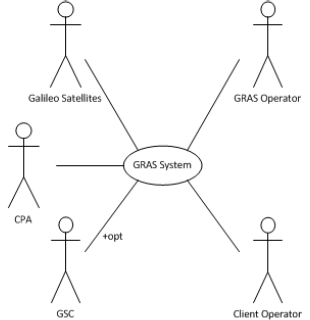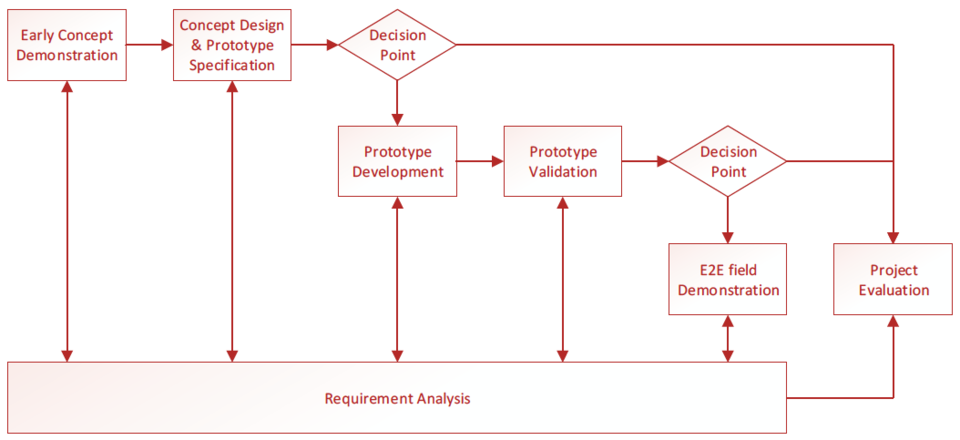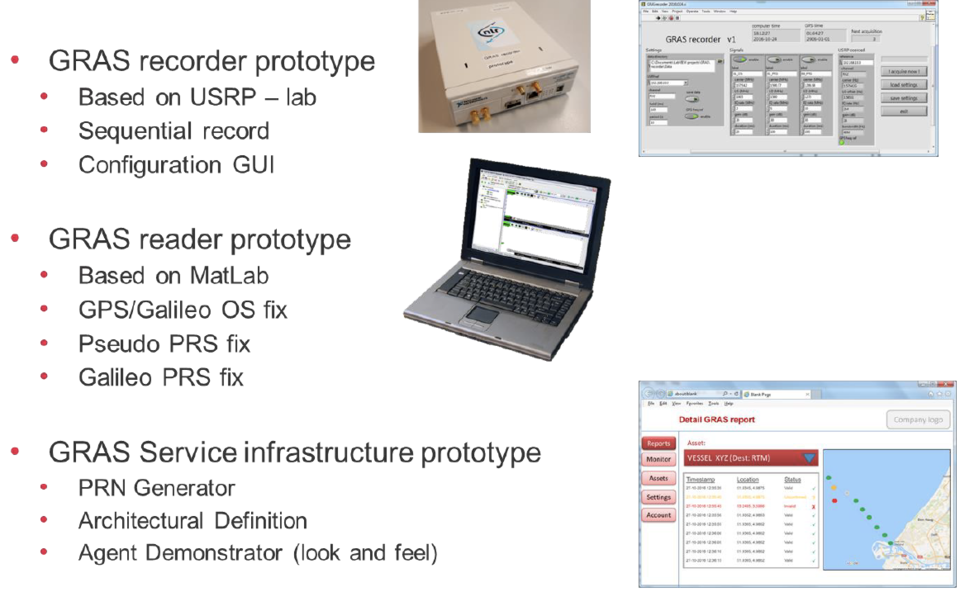GNSS Recorder for Anti Spoofing
GSTP: Make Project: GNSS Recorder for Anti Spoofing (GRAS)
Company |
Country |
Website |
|
| CGI Nederland B.V. (Prime Contractor) | Netherlands | http://www.cginederland.nl/ |  |
| Folkline Enterprises B.V. | Netherlands |  |
|
| Stichting Nationaal Lucht- en Ruimtevaartlaboratorium (NLR) | Netherlands | http://www.nlr.nl/ |  |
| Maanmittauslaitos (National Land Survey of Finland, Finnish Geospatial Research Institute) FGI | Finland | http://www.fgi.fi/ |  |
Public available GNSS technology that provides tracking capabilities can be subject to tampering such as spoofing and can therefore not always be accepted as reliable evidence.
The GRAS concept will protect against these threats by off-line post-processing of recorded baseband spectrum snapshots based on Galileo PRS signals to authenticate positions or tracks based on public GNSS services. These can be the ultimate and reliable proof of the validity of any historic GNSS position or track, or provide an authentic position estimate for each baseband snapshot. This project will demonstrate the technical feasibility of the GRAS concept.
Objectives

The GRAS project objective was the end-to-end technological demonstration of a service by capturing the GNSS spectrum snapshots including both Open and PRS Signals in Space using a prototype Recorder and developing a Reader prototype for processing the PRS signals contained within these snapshots.
Short samples (snapshots) of the GNSS spectrum (including both Open and PRS Signals in Space) are recorded for off-line processing in a central secure server. The snapshot spectrum samples can then be used either to authenticate measurements from the publicly available signals or to derive a PRS based position solution.
Also a preliminary architectural design was established for the Service Infrastructure that is required to connect the Reader with the Recorders in the field and integrate the necessary classified PRS components.
Features

The GRAS logical design is based on Use Cases and flowed down user and security requirements. The GRAS System interacts with a number of external actors. The following System Context Diagram (SCD) depicts the actors involved within the scope of the GRAS system.

A preliminary logical design for the GRAS system has been established. This design aims to support a wide variety of Use Cases as defined by the user and security requirements and allows for smooth integration with existing user infrastructure.
Within the current project the key components necessary to demonstrate the feasibility of the GRAS concept have been elaborated. A simplified logical design for the GRAS demonstrator is provided in the figure below. This consists mainly of the recorder and the reader with the additional components from the “Service Infrastructure” needed to manage and operate the reader, to provide the required inputs and to interface the recorded snapshots.
Project Plan
The main objective of this project is to demonstrate the technical feasibility of the GRAS concept with a prototype system. Five stages are identified to implement the GRAS business case. For this project the first three stages have been executed. Each stage concluded with a decision point where it was decided, if and how to continue with the development of the GRAS concept.
In parallel to these main stages a continuous activity analysed the system requirements both from the various user perspectives and from technical capabilities. The end result of this is used to identify the optimal operational configuration and most promising candidates for launching pilot application demonstrations of the GRAS service.
Key Issues

Critical issues in the development identified for the GRAS concept include:
- Secure environment: The GRAS concept makes use of PRS signals. For the project it is required to have access to the classified PRS documentation and operational keys.
- Recorder technology: In the current project existing RF recording technology has been used for evaluation.. Key to the success of an operational GRAS system is the (future) development of a small and low cost stand-alone high quality GNSS spectrum recorder. The feasibility has been established in the current project.
- Reader technology: The SW receiver from FGI (GSRx) was used as a starting point. The tracking algorithms have been optimised for snapshot processing and introduce tracking of PRS signals.
- Source of PRS PRN codes: For the GRAS demonstrations it was intended to make use of existing technology. In the end, CGI has developed its own PRS PRN generator to be used in the demonstration and evaluation of the GRAS concept.
Expected Main Benefits
Currently it is possible to misrepresent information on tracking devices using the existing Open Signals from GNSS providers (e.g. by spoofing). Various mechanisms to protect against spoofing can be considered. The Galileo PRS (encrypted) signals provide the best possible protection against spoofing, but the deployment of PRS capable receivers is expensive and driven by regulations. The GRAS concept introduces a mechanism to make use of the PRS signal characteristics without the need to deploy PRS capable receivers in the field. The Key Features offered by the GRAS concept are:
- Off-line, accurate, reliable and proven positions that can be used as legal evidence
- The possibility to tamper or spoof the resulting position solutions is reduced to an absolute minimum
- The spectrum samples can also be used to detect spoofing attempts
- Low deployment costs
Potential usage of the GRAS concept is practically limitless, from maritime, aviation and road containers to rental equipment (boats, planes and cars), as well as insurance, fisheries, electronic tagging and monitoring of National Vital Infrastructure through authentication of the Position, Velocity and Time (PVT).
Contact
| Project Manager: | Ron Valk | ron.valk@cgi.com |
|
George Hintzenweg 89 3068 AX Rotterdam The Netherlands |
CGI Nederland B.V. | |
| +31 (0)88 564 0000 | ||
| ESA Technical Officer: | Ricardo Berto-Monleon |















 Germany
Germany
 Austria
Austria
 Belgium
Belgium
 Denmark
Denmark
 Spain
Spain
 Estonia
Estonia
 Finland
Finland
 France
France
 Greece
Greece
 Hungary
Hungary
 Ireland
Ireland
 Italy
Italy
 Luxembourg
Luxembourg
 Norway
Norway
 The Netherlands
The Netherlands
 Poland
Poland
 Portugal
Portugal
 Czechia
Czechia
 Romania
Romania
 United Kingdom
United Kingdom
 Slovenia
Slovenia
 Sweden
Sweden
 Switzerland
Switzerland

























